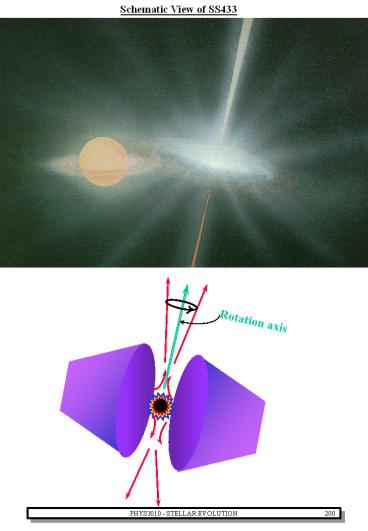Schematic View of SS433 - PowerPoint PPT Presentation
1 / 4
Title:
Schematic View of SS433
Description:
From the available observational evidence it appears that X-ray binary sources ... loss and the recoil momentum do change the period and eccentricity of the orbit. ... – PowerPoint PPT presentation
Number of Views:53
Avg rating:3.0/5.0
Title: Schematic View of SS433
1
Schematic View of SS433
Rotation axis
2
(No Transcript)
3
15.10 COMPACT X-RAY SOURCES AND STELLAR
EVOLUTION
From the available observational evidence it
appears that X-ray binary sources are a natural
product of stellar evolution. The next page
illustrates a possible scenario in which one
stage is an x-ray emitting black hole binary
object. Period changes are caused by mass
transfer and supernovae explosions. Clearly since
a very wide range of starting masses and
separations are possible for the two stars there
will be an enormous variety of such scenarios
possible, with many different end products.
- Initially two main sequence stars , the 20 M0
star exhausts its H core first ( 6 x 106 y)
- The envelope expands and the star fills its
Roche lobe and spills via an accretion disk onto
other star over a period of 2 x 104 y.
- A 20.6 M0 star is formed after 5 x 105 y and
becomes H burning at a rate according to this
higher mass. The primary is now a 5.4 M0 He
burning star.
- The He burning primary completes core burning in
6 x 105 y, then proceeds to core C, O, Si
burning and undergoes a supernova explosion. 3.4
M0 of the mantle is is expelled leaving the 2 M0
core to implode to a either a neutron star or a
black hole. Although the supernova explosion does
not disrupt the binary the mass loss and the
recoil momentum do change the period and
eccentricity of the orbit.
- The binary now consists of the compact object
and the 20.6 M0 star. It is a detached binary
system with eccentric orbits which will
circularise by tidal interactions within several
million years.
- The secondary is a main sequence O or B type
star. After completing its H burning phase its
envelope expands and it becomes a blue supergiant
For period of about 4 x 104 years the star loses
matter in the form of a stellar wind driven by
the high radiation pressure. The compact object
accretes matter and becomes an x-ray source in
the mould of Cygnus X-1.
- After this period the expanding blue supergiant
fills its Roche lobe and a new phase of mass
exchange takes place. An accretion disk forms
around the compact object. Most of the
x-radiation produced will be absorbed by the
dense accreting material and the only x-rays
likely to escape will be those emitted normal to
the plane of the accretion disk. The rate of
accretion will be limited by the Eddington
luminosity limit. During this phase the compact
object is likely to gradually grow in terms of
mass.
Taken from Astrophysics I (Bowers and Deeming) P
326.
4
STAGES IN THE EVOLUTION OF A MASSIVE CLOSE BINARY
SYSTEM































